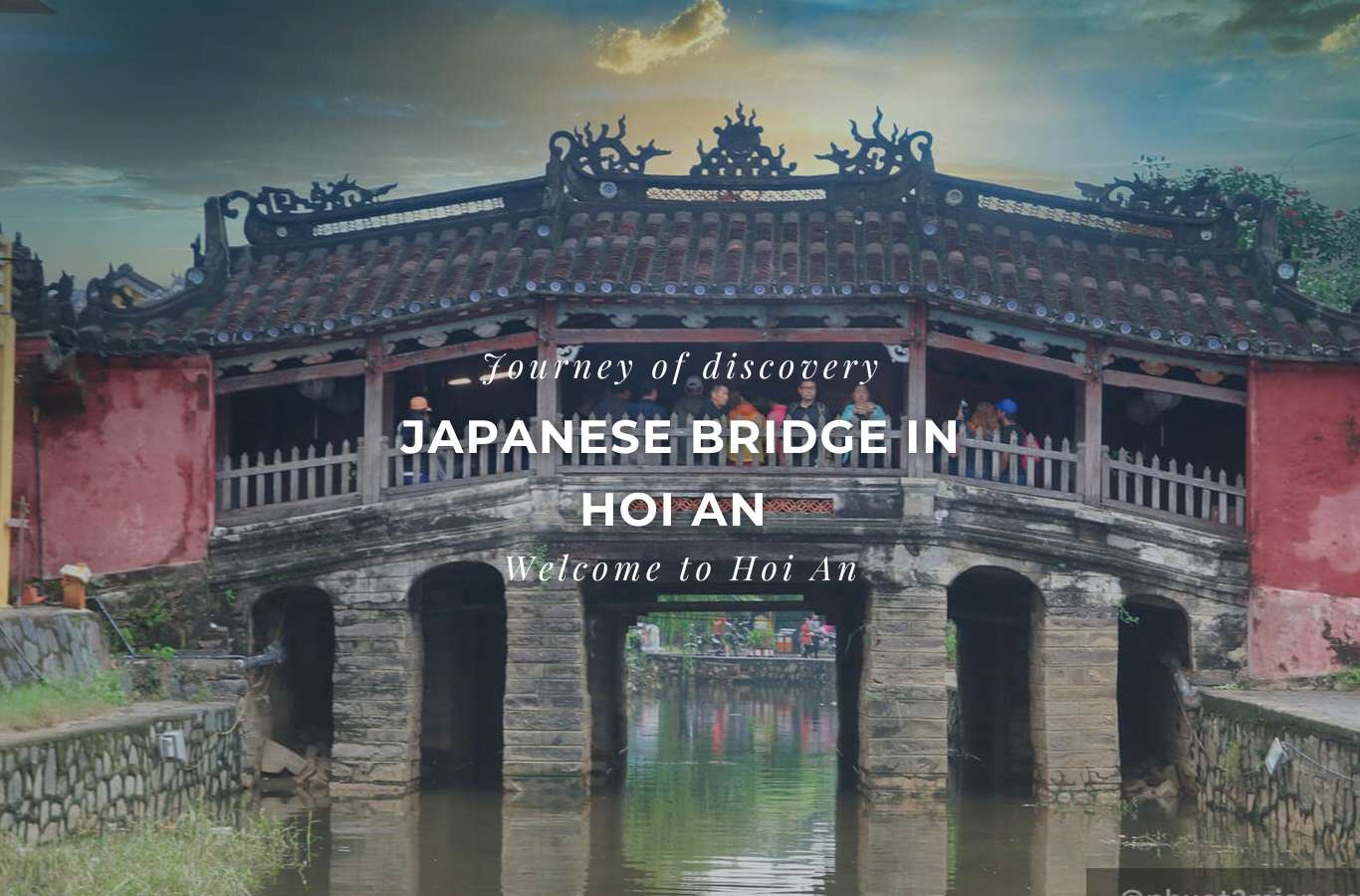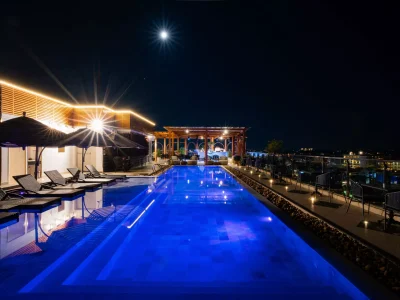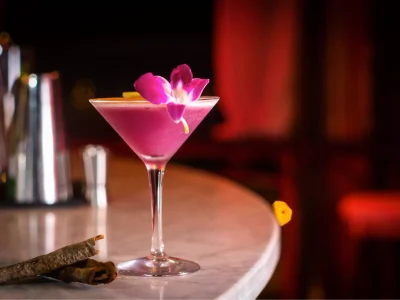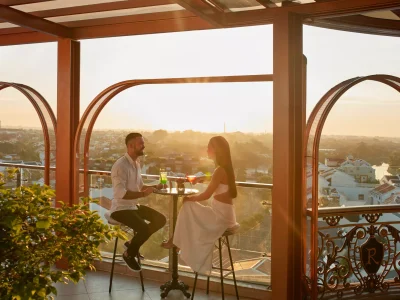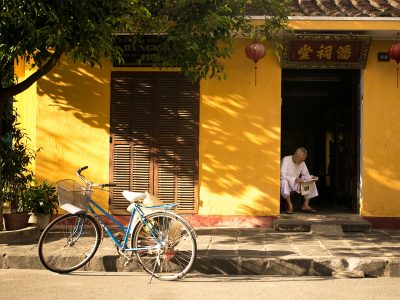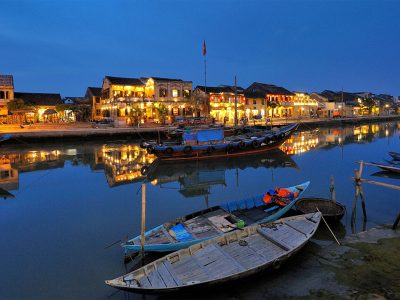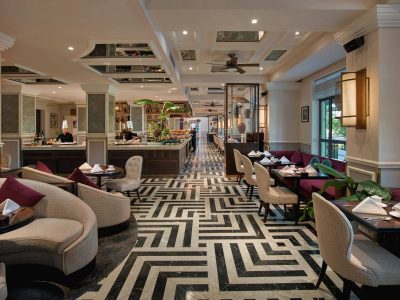Japanese Bridge in Hoi An is a unique architectural structure that reflects the deep cultural significance of Hoi An’s Ancient Town. This iconic landmark has become closely connected with the local community, attracting visitors from around the world. In the article below, Hotel Royal Hoi An Gallery will take you on a journey to explore the Japanese Covered Bridge, an unmissable destination in Hoi An!
Table of Contents
ToggleHistory and origins of the Japanese Bridge
Japanese Bridge is an architectural symbol with significant historical meaning, representing the cultural fusion of Japan, Vietnam, and China in Hoi An. Over 400 years old, the bridge has undergone several restorations but still retains its original ancient design, becoming an integral part of the spiritual and religious life of the locals.
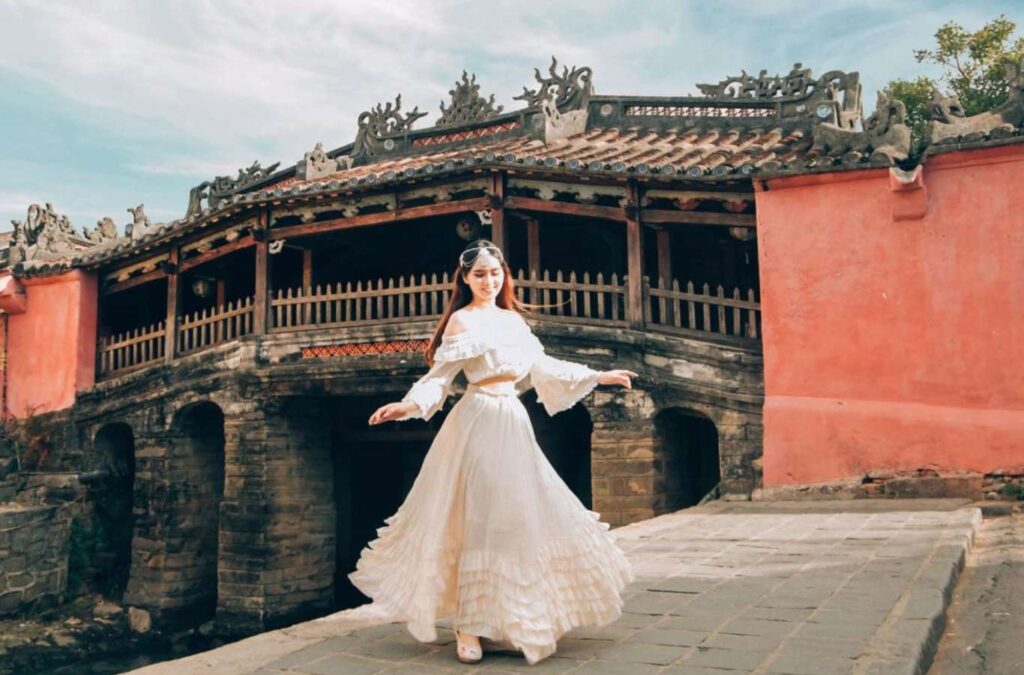
The bridge was built in 1593 by Japanese merchants living in Hoi An. Originally named the Japanese Bridge, it was constructed to connect the Japanese and Chinese communities and to ward off the namazu, a mythical creature believed to cause natural disasters. According to legend, the namazu has its head in India, its body in Vietnam, and its tail in Japan, often causing calamities when it moves. The bridge was designed as a sword to stab the creature, helping to protect all three countries from floods and earthquakes.
In 1719, Lord Nguyen Phuc Chu visited and renamed the bridge Lai Viễn Kiều, meaning “Bridge for Welcoming Guests from Afar.” Around the same time, a small shrine was built on the bridge, and it became known as the Japanese Bridge.
Read more:
30+ Hoi An tourist destinations that you should not miss
Hoi An Ancient Town: A Detailed Travel Guide
What is the best season to visit Hoi An? Let’s explore it
Unique architecture of the Japanese Bridge in Hoi An
Japanese, Chinese, and Vietnamese architectural styles
Chua Cau is a remarkable symbol of cultural convergence in Hoi An, blending the refined aesthetics of Japanese architecture, the elaborate carvings of Chinese design, and the soulful charm of Vietnamese tradition. Its wooden structure and yin-yang tiled roof embody a timeless harmony across three civilizations.
Yin-yang roof
The yin-yang roof is one of the distinctive features of the bridge. This type of roof helps regulate temperature and holds symbolic meaning, representing harmony between heaven and earth. It is a typical style seen in ancient buildings in Hoi An.
Wooden monkey and dog statues
The ends of the bridge are decorated with wooden statues of a monkey and a dog, representing the years the bridge was started and completed (the Year of the Monkey and the Year of the Dog). According to Japanese beliefs, these spiritual creatures are tasked with protecting the bridge from evil spirits and natural disasters.
The shrine to Bac De Tran Vo
A small shrine dedicated to Bac De Tran Vo, the protective deity who brings peace and prosperity, is located in the center of the bridge. The shrine is intricately designed, blending Vietnamese, Chinese, and Japanese styles. It is a place where locals pray for health and safety.
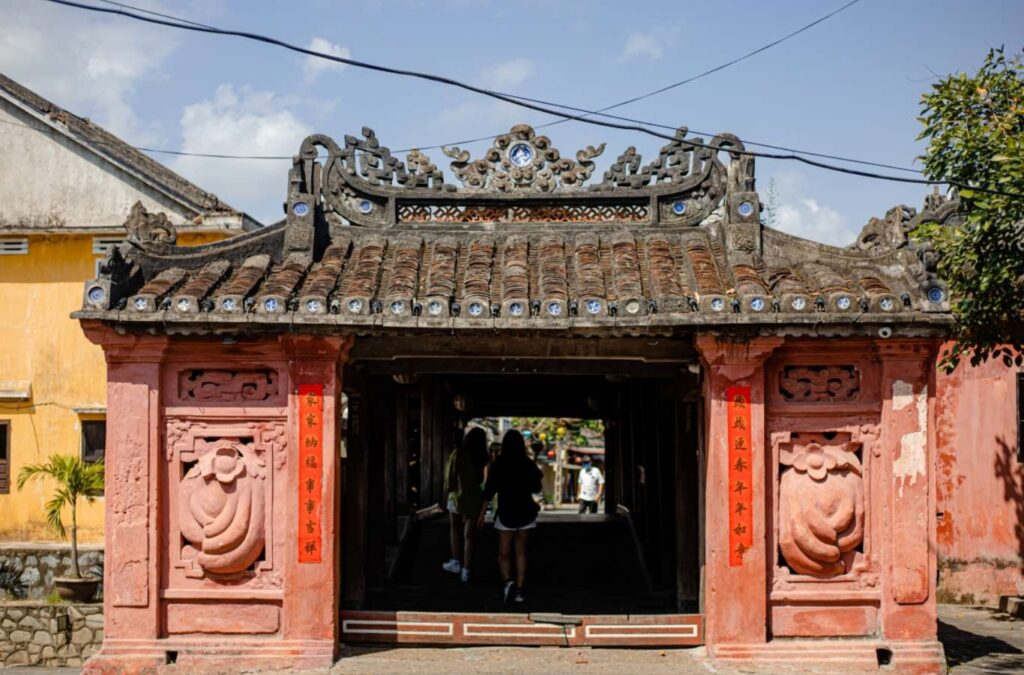
The significance of the Japanese Bridge in the community life of Hoi An
A hub of trade and East Asian culture
The Japanese Bridge once played a crucial role in trade activities between Japanese, Chinese, and Vietnamese merchants in the 17th century. Its location over a small canal facilitated the transportation of goods and became a cultural exchange point. The bridge’s architecture and presence are a clear symbol of the cultural intersection between East Asian countries in Hoi An. The carved details and construction style reflect the cooperation and harmony between the nations of the region.
Spiritual significance and traditional ceremonies
Beyond its role as a functional bridge, the Japanese Covered Bridge holds deep spiritual significance for the locals. The shrine to Bac De Tran Vo is a place where people frequently come to pray for peace, health, and prosperity. During major festivals and the Lunar New Year, the bridge becomes the center for religious ceremonies. This reflects the belief in the supernatural forces protecting the town from disasters, especially floods and water-related calamities.
Read more: Hoi An’s ancient architecture, a fusion of culture
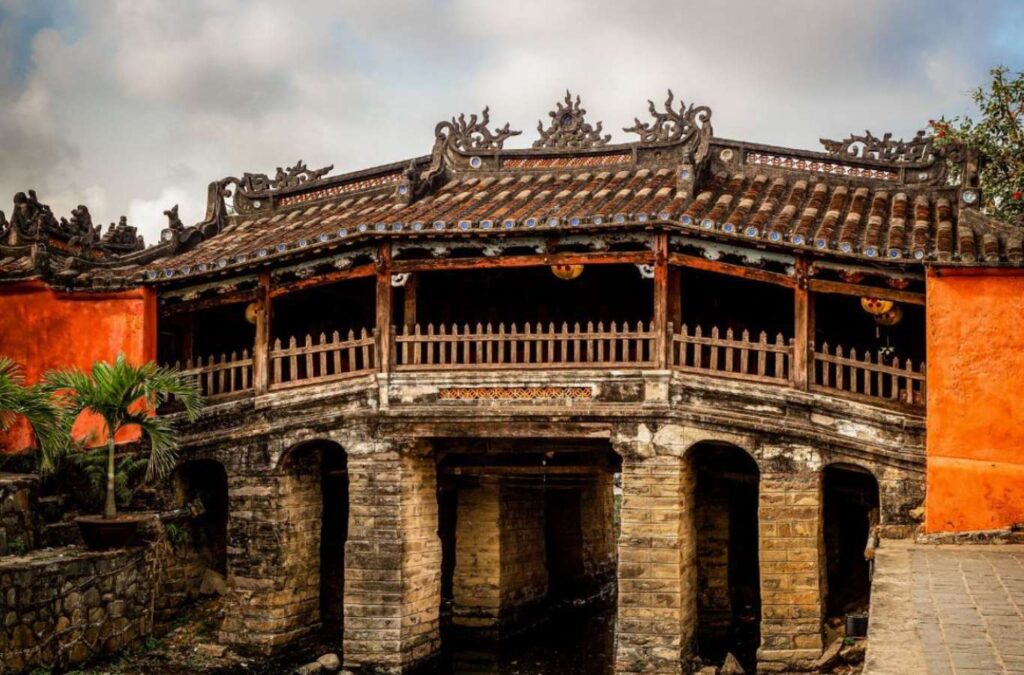
The Japanese Covered Bridge in memory and modern life
For the people of Hoi An, Chua Cau is a symbol of memory and pride. Its image appears on Vietnam’s 20,000 VND polymer banknote, underscoring the cultural and historical significance of this iconic structure.
Today, Chua Cau is not only a famous tourist attraction but also a place that preserves the stories of Hoi An’s history and development over the centuries. Locals and visitors alike come here to find peace, nostalgia, and a deeper understanding of the ancient town’s unique culture.
Visitor’s guide to the Japanese Bridge in Hoi An
Activities at the Japanese Covered Bridge
Visitors to the Japanese Covered Bridge can enjoy the following activities:
- Admire the unique architecture that blends Japanese, Vietnamese, and Chinese cultures.
- Learn about the history and legends related to the bridge and the Bac De Tran Vo shrine.
- Take photos at the beautiful spots, especially in the evening when the bridge is illuminated by colorful lanterns.
- Participate in prayer ceremonies for peace and health at the shrine on the bridge.

Ideal time to visit the Japanese Bridge in Hoi An
The best time to visit the Japanese Covered Bridge is early in the morning, when the atmosphere is fresh, and there are fewer visitors, making it perfect for photography and enjoying the peaceful environment. Visitors can also come in the evening, when the lantern lights create a magical and romantic setting.
Read more: [2025] Nightlife in Hoi An: Top 11 experiences to explore
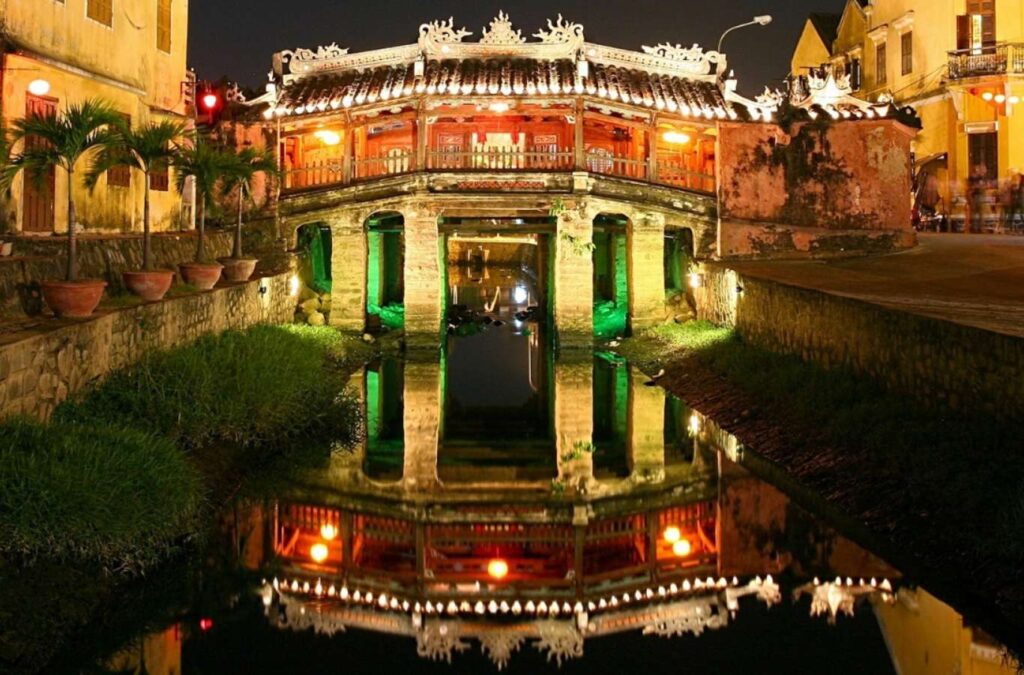
Transportation to the Japanese Bridge in Hoi An
Tourists can reach the Japanese Covered Bridge by:
- Motorbike or Car: You can park outside the Ancient Town and walk to the bridge.
- Bicycle: Ideal for exploring the Ancient Town, easy to move around and stop at nearby attractions.
- Walking: The Ancient Town restricts motor vehicles, so walking is the best way to explore.
Entrance fees and related services
Entrance fees:
- Vietnamese visitors: 80,000 VND/person.
- Foreign visitors: 150,000 VND/person. (The ticket includes access to 21 sites in the Ancient Town, including the Japanese Covered Bridge.)
Guided tour services: Visitors can hire a guide to learn more about the history and cultural significance of the bridge.
Accommodation near the Japanese Covered Bridge
Visitors to Hoi An can consider staying at:
- Hotel Royal Hoi An: Hotel Royal Hoi An, nestled along the poetic Thu Bon River, is one of the most luxurious hotels in Hoi An. With its refined design that blends Japanese aesthetics and classic Indochine architecture, the hotel offers a unique and enchanting retreat. From here, guests can easily explore the UNESCO-recognized Hoi An Ancient Town, while also enjoying the natural beauty and rich culinary heritage of Central Vietnam. Every detail at Hotel Royal Hoi An is crafted to deliver an unforgettable stay, where elegance meets cultural charm.
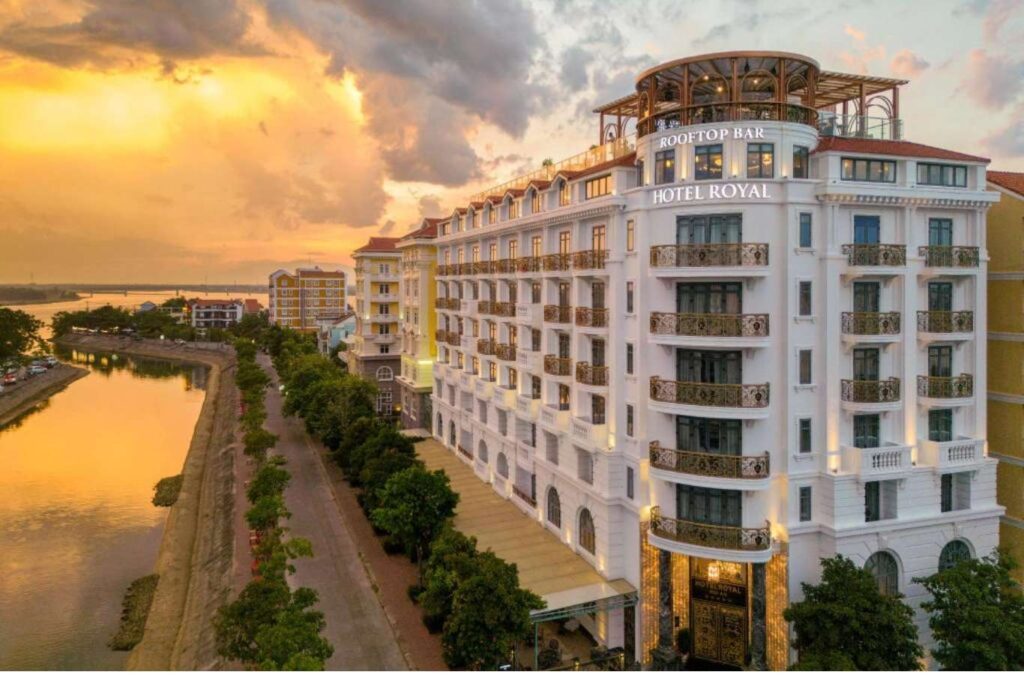
- Vinpearl Resort & Golf Nam Hoi An: 14.6 km from the Japanese Bridge, this upscale resort offers modern amenities.
- Homestays and small hotels in the Ancient Town: Perfect for tourists who want to stay close to the Japanese Covered Bridge for easy sightseeing.
Tips for visiting the Japanese Bridge in Hoi An
To make your visit to the Japanese Covered Bridge more enjoyable, keep in mind the following tips:
- Follow the visiting rules: Visitors should avoid writing or drawing on the bridge or surrounding structures. Do not climb or engage in actions that could damage the monument.
- Dress appropriately: As this is a site of spiritual significance, visitors are advised to dress respectfully and modestly. In particular, when entering the shrine dedicated to the Northern Emperor Tran Vo, it is recommended to avoid wearing revealing or overly short clothing as a sign of respect.
- Keep the area clean: Do not litter in the area. Use public trash bins or take your trash outside the Ancient Town to preserve the cleanliness and beauty of the site.
- Protect your personal belongings: The Ancient Town can be crowded, especially during festivals. Be mindful of your personal belongings to avoid losing them.
The Japanese Bridge in Hoi An is a living testament to the cultural and historical beauty of Hoi An over the centuries. It is certainly a must-visit destination that will not disappoint any traveler visiting Hoi An. Hotel Royal Hoi An proudly welcomes visitors to explore the Japanese Covered Bridge and stay in your journey through this historic town!


